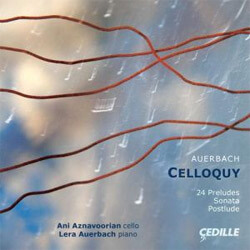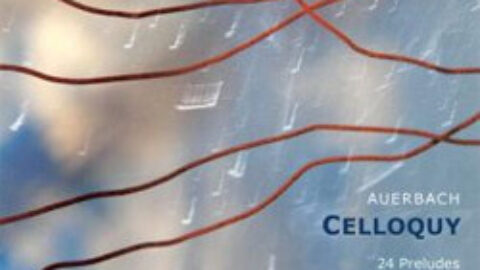 Lera Auerbach’s Celloquy is a lesson in learning how to expect the unexpected. For one, the album released on Cedille Records does not feature the said instrument in conversation with itself, as the title seems to imply. Instead, cellist Ani Aznavoorian’s boldly textured and multifarious playing is partnered by Auerbach’s fearless piano throughout the album. The resulting music—in the form of 24 Preludes (1999), Sonata (2002), and Postlude (2006)—is kaleidoscopic in quality, offering listeners an ever-changing array of sounds which speak directly to the breadth and virtuosity of both performers.
Lera Auerbach’s Celloquy is a lesson in learning how to expect the unexpected. For one, the album released on Cedille Records does not feature the said instrument in conversation with itself, as the title seems to imply. Instead, cellist Ani Aznavoorian’s boldly textured and multifarious playing is partnered by Auerbach’s fearless piano throughout the album. The resulting music—in the form of 24 Preludes (1999), Sonata (2002), and Postlude (2006)—is kaleidoscopic in quality, offering listeners an ever-changing array of sounds which speak directly to the breadth and virtuosity of both performers.

24 Preludes serves as a fantastic platform for showcasing such talent. Each prelude is fairly short in length, ranging from fifty seconds to five minutes long, and as a full body of work, 24 Preludes cycles through all major and minor keys à la Bach’s Well-Tempered Clavier. What places Auerbach’s composition far away from tradition, however, is its audaciousness, putting heavy emphasis on tonal experimentation and textural complexity in a collection of concise pieces which, under normal circumstances, would not provide sufficient time for such depth of exploration. Auerbach manages to do so with great mastery though, as she designed her preludes to feed into one another like beads on a statement necklace; together they form a continuum. With this in mind, Allegro Con Brio (Track 15) and Tempo Di Valser (Track 16) are perhaps the best set of preludes to listen to in order to get a solid feel for Auerbach’s musical intentions overall.
The Sonata, on the other hand, is much meatier in terms of lyrical content, each movement expanding upon Aznavoorian and Auerbach’s partnership allowing them to soar to vulnerable heights—Allegro Moderato ends precisely that way, in a tense upward glissando—and settle into warm depths without the need for taking constant breaths in between. Lament (Adagio) strays from this form though as it plays out in a different manner, stretching out horizontally instead. The second movement is, as a result, one of the more melodious pieces to be presented in the album. Pockets of fury from 24 Preludes are carried over into the third movement of the Sonata, Allegro Assai. This piece is an expulsion of sorts, a letting loose of pent up energy that ultimately gives way to the fourth and final movement, Con Estrema Intensità. This is no doubt the most haunting piece from Celloquy, especially given that the image Auerbach had in mind when writing it is “that of standing at the edge of an abyss, where nothing is left of the past or the future.” Upon listening to the final seconds of this movement, it is hard to imagine anything else quite so vividly.
 Just when the past is thought to be a thing of oblivion, however, Auerbach resurrects the familiar tune of Prelude No. 12 in her Postlude, this time transforming it with the tinny, harpsichord-like sounds of a prepared piano. The tone of Aznavoorian’s cello, too, is thinned by the use of a mute, resulting in the dampening of the strings. The two instruments, gutted of their previous vivacity and soulfulness, seem now to be wading through the heaviness of time, as if to express through music the final stanza of Auerbach’s poem “Fugue” found in the CD insert:
Just when the past is thought to be a thing of oblivion, however, Auerbach resurrects the familiar tune of Prelude No. 12 in her Postlude, this time transforming it with the tinny, harpsichord-like sounds of a prepared piano. The tone of Aznavoorian’s cello, too, is thinned by the use of a mute, resulting in the dampening of the strings. The two instruments, gutted of their previous vivacity and soulfulness, seem now to be wading through the heaviness of time, as if to express through music the final stanza of Auerbach’s poem “Fugue” found in the CD insert:
Except no one is waiting
for me at the other end,
there is no applause nor greeting,
no bravi, but only
that moment of infinite
loneliness
when sound dies.
While Celloquy ends on a note of despair, it also leaves listeners waiting at the other end in rapturous applause for the myriad of illuminating nuances that Auerbach and Aznavoorian deliver throughout the album. The moment of infinite loneliness when sound dies is then, in hindsight, simply a realization of the beauty of transience.
Lera Auerbach, Celloquy (Cedille, 2013) Buy on Amazon.com | Buy on Amazon.ca | Buy on Amazon.co.uk
























